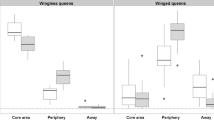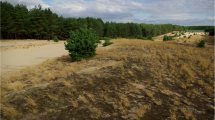Summary
For each of three species of dolichoderine ants, four mating system models were tested electrophoretically. The models tested were: (1) each colony is derived from one, singly-inseminated female, (2) each colony is derived from one female, inseminated twice, (3) colonies have two, coequal, singly-inseminated queens, and (4) colonies have three, coequal, singly-inseminated queens. From each of these models, expected frequencies of colonies of various genotypic compositions were calculated. Goodness of fit of actual colony types were then tested.
Conomyrma insana colonies were shown to be monogynous. A large number of theConomyrma bicolor colonies studied are functionally polygynous. Polygyny occurs in all localities examined. Polygyny may also occur inIridomyrmex pruinosum. Its occurence may be less widespread than inC. bicolor.
Resume
Pour chacune des trois espèces de fourmis de la famille Dolichoderinæ, quatre modèles de reproduction des colonies ont été examinés par électrophorèse: (1) chaque colonie provient d'une seule femelle inséminée une seule fois, (2) chaque colonie provient d'une seule femelle inséminée deux fois, (3) les colonies proviennent de deux reines «égales», chacune inséminée une seule fois, et (4) les colonies proviennent de trois reines «égales», chacune inséminée une seule fois. Pour chacun de ces modèles, la fréquence des colonies de chaque composition génétique a été calculée et comparée avec la distribution observée.
Les colonies étudiées deConomyrma insana sont de type monogyne. Un grand nombre des colonies étudiées deConomyrma bicolor sont de type polygyne fonctionnelle. La polygynie se trouve dans toutes les localités examinées. Peut-être la polygynie se trouve-t-elle aussi chezIridomyrmex pruinosum. Sa fréquence est peut-être moins grande que chezC. bicolor.
Similar content being viewed by others
References
Ayala F.J., Powell J.R., Tracey M.L., Mourão C.A., Perez-Salas S., 1972. — Enzyme variability in theDrosophila willistoni group. IV: Genic variation in natural populations ofDrosophila willistoni.Genetics, 7, 113–139.
Baroni-Urbani C., 1968. — Monogyny in ant societies.Zool. Anz., 181, 269–277.
Berkelhamer R.C., 1980. — Reproductive strategies in ants: A comparison of single-queened versus multiple-queened species in the subfamily Dolichoderinae (Hymenoptera: Formicidae).Ph. D. Thesis, Univ. of California, Berkeley.
Bradley J.V., 1968. —Distribution-free statistical tests. Prentice-Hall, Englewood Cliffs, U.S.A.
Buschinger A., 1968. — Mono- und Polygynie bei Arten der GattungLeptothorax Mayr (Hymenoptera Formicidæ).Ins. Soc., 15, 217–226.
Buschinger A., 1970. — Zur Frage der Monogynie oder Polygynie beiMyrmecina graminicola (Latr.) (Hym., Form.).Ins. Soc., 17, 177–182.
Hölldobler B., Wilson E.O., 1977. — The number of queens: an important trait in ant evolution.Naturwissenschaften, 64, 8–15.
Nickerson J.C., Cromroy H.L., Whitcomb W.H., Cornell J.A., 1975. — Colony organization and queen numbers in two species ofConomyrma.Ann. Entomol. Soc. Am., 68, 1083–1085.
Pamilo P., Crozier R.H., 1982. — Measuring genetic relatedness in natural populations: methodology.Theoret. Pop. Biol., 21, 171–193.
Pamilo P., Varvio-Aho S., 1979. — Genetic structure of nests in the antFormica sanguinea.Behav. Ecol. Sociobiol., 6, 91–98.
Ward P.S., 1978. — Genetic variation, colony structure, and social behavior in theRhytidoponera impressa group, a species complex of ponerine ants.Ph. D. Thesis, Univ. of Sydney.
Author information
Authors and Affiliations
Rights and permissions
About this article
Cite this article
Berkelhamer, R.C. An electrophoretic analysis of Queen number in three species of Dolichoderine ants. Ins. Soc 31, 132–141 (1984). https://doi.org/10.1007/BF02232710
Received:
Accepted:
Issue Date:
DOI: https://doi.org/10.1007/BF02232710




